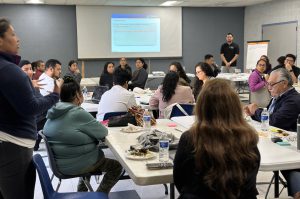
Advancing a Collaborative Agenda in Southeast LA
Advancing a Collaborative Agenda in Southeast LA In 2022, the California Community Foundation (CCF) launched the Regional Recovery Hub to strengthen place-based coordination in Los Angeles County
Variable Definitions:
Born In-State: The percentage of the population that was born in California
Born Out-of-State: The percentage of the population that was born in another U.S. state other than California
Source:
American Community Survey (ACS), 5-year estimates, Table B06001
Years Available:*
2011-2023
*Note: Each year of available data shown above is a 5-year estimate, or an average of data collected over a five year period. 5-year estimates are used to increase the reliability of the data at small geographies like neighborhoods and census tracts. The years shown on the NDSC map represent the final year of the five year average (e.g. “2010” represents 2006-2010 data, “2011” represents 2007-2011 data, and so on). For the most impactful comparison of data over time, the ACS recommends comparing non-overlapping years (e.g. 2010-14 with 2015-19).
California, known for its diverse landscape and vibrant culture, has historically been a “sticky” state, meaning that a significant portion of its residents were born in-state. According to a study by the Dallas Federal Reserve, the majority of Californians are natives, underscoring the state’s ability to retain its population over generations (Dallas Fed, 2023). This retention can be attributed to the state’s economic opportunities, job growth, and overall quality of life, which have long attracted and kept residents within its borders.
However, recent trends indicate a growing number of Californians are moving out of the state. Research by Cain and Hehmeyer (2023) reveals that despite California’s appeal, there is a noticeable population drain as individuals seek affordability and satisfaction elsewhere. These trends highlight a dual narrative: while California’s diverse population continues to attract individuals from across the United States, issues such as high living costs and housing shortages are driving some residents away. This migration dynamic reflects the complex interplay between the state’s economic opportunities and its living costs, suggesting that while California offers many benefits, there are also significant challenges that need to be addressed to maintain its population stability.
Understanding the percentage of the population born in-state versus out-of-state is crucial for several reasons. First, it provides insight into the demographic composition of California’s population, helping policymakers and researchers understand who resides in the state and where they come from. This knowledge is essential for planning public services, infrastructure, and housing needs. Additionally, analyzing these trends helps track how migration patterns change over time, offering a lens into the broader social and economic shifts occurring within the state.
Moreover, this measure can reveal the state’s ability to attract and retain talent, which is vital for sustaining economic growth and innovation. A high proportion of Californian-born residents may indicate strong local roots and community ties, while a significant number of transplants can point to California’s appeal to newcomers seeking new opportunities. Overall, these demographic insights are invaluable for shaping policies that address the needs of both long-term residents and new arrivals.
Written by Xitong Lu
Citations:
Cain, B. E., & Hehmeyer, P. (2023). California’s population drain. Stanford Institute for Economic Policy Research (SIEPR). Retrieved from https://siepr.stanford.edu/publications/policy-brief/californias-population-drain
Dallas Federal Reserve. (2023). California’s population trend. Retrieved from https://www.dallasfed.org/research/economics/2023/0829
Johnson, H., & McGhee, E. (2024). Who’s leaving California—and who’s moving in? Public Policy Institute of California. Retrieved from https://www.ppic.org/blog/whos-leaving-california-and-whos-moving-in/
U.S. Census Bureau. (1850-1990). United States Censuses.
U.S. Census Bureau. (2000-2020). American Community Surveys.

Advancing a Collaborative Agenda in Southeast LA In 2022, the California Community Foundation (CCF) launched the Regional Recovery Hub to strengthen place-based coordination in Los Angeles County

Every ten years, the federal government conducts a “census,” where it counts every person living in the United States. The constitution mandates that all people

Our nation’s population is aging and will continue to grow older over the next several decades. There are currently 49.2 million people ages 65 and
